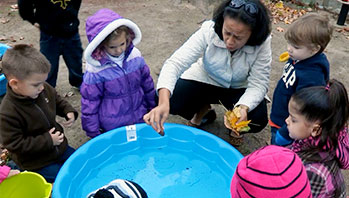- boxes and other objects (ramp base)
- camera or cell phone with camera
- clipboards
- flat pieces of cardboard
- objects to roll and slide down ramps (toilet paper and paper towel tubes, markers, rolls of duct tape, balls of various sizes and weights, toy cars, blocks, boxes, squares of cardboard)
- fast
- faster
- ramp
- roll
- slide (v.)
- slow
MA Standards:
Language/L.PK.MA.6: Use words and phrases acquired through conversations, listening to books read aloud, activities, and play.
MA Draft STE Standards:
Physical Sciences/Motion and Stability; Forces and Interaction/PS2.A: Plan and carry out investigations of the behaviors of moving things.
Physical Sciences/Motion and Stability; Forces and Interaction/PS2.B: Using evidence, discuss ideas about what is making something move the way it does and how some movements can be controlled. [Cause and Effect, Stability and Change]
Head Start Outcomes:
Science Knowledge/Scientific Skills and Method: Collects, describes, and records information through discussions, drawings, maps, and charts.
Approaches to Learning/Cooperation: Plans, initiates, and completes learning activities with peers.
Approaches to Learning/Cooperation: Joins in cooperative play with others and invites others to play.
PreK Learning Guidelines:
English Language Arts/Language 2: Participate actively in discussions, listen to the ideas of others, and ask and answer relevant questions.
Science and Technology/Inquiry Skills 4: Record observations and share ideas through simple forms of representation such as drawings.
Science and Technology/Physical Sciences 25: Explore and identify simple machines such as ramps, gears, wheels, pulleys, and levers through play experiences.
Explore Together (outdoors): Free Ramp Exploration

© Commonwealth of Massachusetts, Department of Early Education and Care. All rights reserved.
STEM Key Concepts: Understand that a ramp, or inclined plane, is a surface with one end higher than the other; Recognize that an object placed on an inclined plane will roll, slide, or stay put; Understand that the shape of an object affects whether it will roll or slide or stay put; Describe the way objects move when they are placed on ramps; Identify tools and simple machines used for a specific purpose, e.g., ramp, wheel, pulley, lever
ELA Focus Skills: Predicting, Speaking and Listening, Vocabulary
Bring the ramp materials outdoors. Allow children to spread out and freely explore making ramps and testing their ideas about rolling and sliding.
Observe children as they work. You may want to record predictions they make, as well as the action that follows a prediction.
- Have children record their observations on paper or with a video if possible.
Reflect and Share
Have children talk about their discoveries. Share the photos or videos. Ask questions such as,
- Why do you think the tin can rolled slower than you predicted? How did you make it roll faster?
- Why do you think the basketball rolled faster down the hill than you did?
- Why do you think the car rolled fast down the cardboard ramp but very slow down the hill?
Take It Further: After children have explored their ramps, take them for a walk around the school to identify ramps in the environment. Discuss the use/reason for each ramp. (sidewalk ramp; ladders; roofs, etc.)
English Language Learners: Point to each of the different materials for the activity. Say the word for each item clearly and have children repeat it after you.
